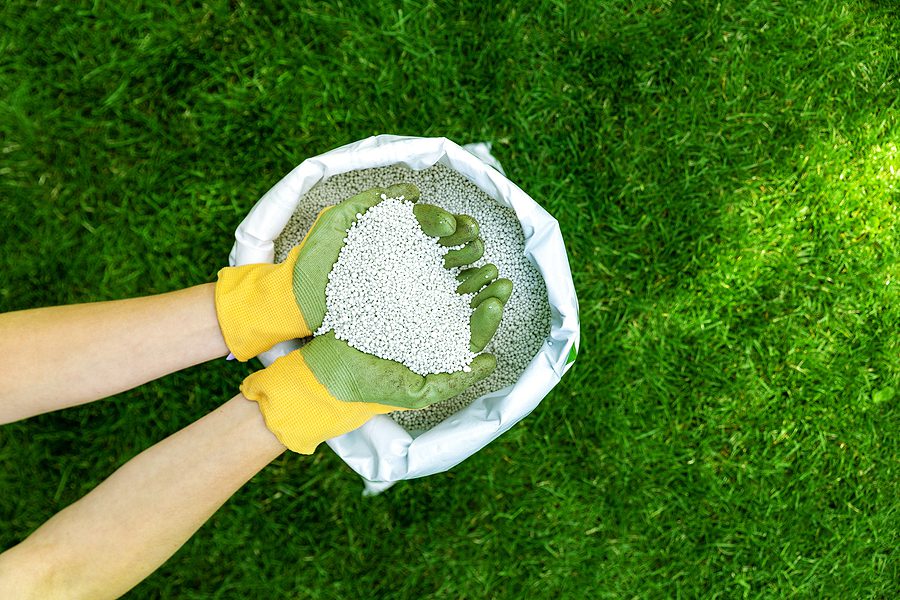Easy Steps to Follow to Achieve Successful Albuquerque Lawn Fertilization

The secret to a successful and gorgeous Albuquerque lawn is the amount of proper nutrients it receives. Here, we’ll give you a strategy to create your perfect Albuquerque lawn by picking the top fertilizer, applying it correctly and creating a smart fertilizer monthly game plan.
Deciphering a Fertilizer Label
The magic of a successful Albuquerque lawn lies in the three primary nutrients that help grow the grass. These can be found on the fertilizer bag as follows:
- Nitrogen Fertilizer (first number listed)
- Phosphorus Fertilizer (second number listed)
- Potassium Fertilizer (third number listed)
By industry standards, the 3 numbers listed are in the same order, being 20 – 5 – 10. This breaks down into:
- 4 parts nitrogen (the first number listed)
- 1 part phosphorus (the second number listed)
- 2 parts potassium (the third number listed)
Nitrogen is the most critical fertilizing nutrient and is very important to a thriving lawn. Optimally, you should look for a lawn fertilizer that features “slow-release nitrogen”, which releases the nitrogen over a period of several weeks. This gives your lawn a constant feed over time and doesn’t deliver it all at once. By using slow-release nitrogen, you can reduce the risk of it burning your lawn, causing serious permanent damage.
If you experience bare spots on an existing or new lawn, you should use starter fertilizer with a proportionately higher-level weight wise of phosphorous. This allows your lawn to grow roots from the seedlings.
Lawn Fertilizing Yearly Schedule
The minimum amount that your lawn needs to be fertilized is 3 times per year. However, lawns should only be fertilized during growth season and never during a drought. The smart way you can schedule lawn fertilization is at the same time of year. So ideally, align it with these annual holidays:
- Memorial Day
- July 4th
- Labor Day
As the southern part of the USA has warm season grasses, it’s a good idea to add an extra fertilizing session around the beginning of August. In the northern USA – with cool season grasses – aim for early to mid-November. This will go a long way to creating a stunning lawn during the upcoming spring.
When a drought is happening and there’s very little rain, stop using fertilizer altogether. This will lower the amount of nutrients your lawn receives during the drought, slow down growth and eventually go dormant. Another piece of what may seem like counter-indicative advice is to water less often. It’s advisable to start your fertilizer schedule in early fall once there is more rainfall and the weather cools off.
Fertilizing Action Plan
So now you are aware of the top fertilizer for your lawn and when you should fertilize dependent on where you live, the next step is to set up a fertilizing action plan, as follows:
- Buy a premium fertilizer spread from your local home and garden center, or Big-Box Home Improvement retail store.
- Once your lawn has been recently mowed – and preferably with a fresh bit of dew – use your fertilizer spreader to add fertilizer to your lawn. This ensures your fertilizer is laid out evenly. The fresh dew helps you to see where the fertilizer has been added so you don’t double-up and you don’t miss any spots.
- Set up your fertilizer spreader placed 5 to 9 feet of the product on grass as it’s being spread. For homes with bigger yards, it’s probably a good idea to set up guides on the lawn so the application is as it should be – not overdone in some areas and short in others.
- If you lower the spreader setting to 50%, you can ensure the fertilizer is applied evenly. This applies the fertilizer at 50% at a time per pass. This is a method that is used by greenskeepers, groundskeepers and professional landscapers.
The reason it’s applied in this way is so that you don’t get unusual darker or lighter swaths of grass throughout the lawn, baseball field or golf course.
- To ensure your fertilizer is dispersed evenly, begin moving forward before turning the spreader on, and turn it off just before you get to the end.
- It’s important that you clean out your fertilizer spreader after each use with soap and water. Most fertilizers contain salt which can cause damage if left uncleaned.
- After you have applied the fertilizer, water the lawn if possible. If you suspect it is about to rain, apply the fertilizer before the rain starts. The addition of water improves the effect the fertilizer has on your lawn.
The Negative Impact of Too Much Fertilizer
There are several negative outcomes, which include:
- Sometimes a lawn will grow too well if it is over-fertilized. This is an issue because it means you will need to mow it more often, but also it means you may violate the 1/3rd leaf blade cut rule.
This rule states that you should never cut more than 1/3rd of the blades of glass on your lawn. If you continue to violate this rule, it will encourage weed growth – something we all want to avoid.
When lawns are too wet and over-fertilized, problems such as Pythium and brown patch occur. Both are turfgrass diseases that require a special fungicide to get rid of them. If you’ve exceeded the manufacturer’s instructions with your application of fertilizer, the lawn will change color to a light brown or yellowish straw color. The leaf blades burn up from the top of the blade down. Unfortunately, if this happens, any grass that has been ruined by too much fertilizer and is therefore dead will need to be replaced with new grass.
